3. Innovation activity related to products and processes in 2010 to 2012
One in three enterprises launch product innovations on the markets
Approximately one-third of surveyed enterprises reported that they had launched product innovations on the markets during the survey period. In industries where innovations are more commonplace, seven enterprises out of ten reported that they had launched product innovations in the three year period.
In manufacturing, product innovations naturally focus on goods but as the importance of services has grown in many industries, the share of enterprises that have launched service innovations on the markets is also considerable. Similarly, product innovations are built on both services and goods in service industries as well.
The share of enterprises that had introduced product innovations to the markets remained at previous years' levels both in manufacturing and services, in 2010 to 2012 all in all 34 per cent in manufacturing and 28 per cent in services.
Figure 4. Enterprises with product innovations by industry in manufacturing 2010–2012, share of enterprises
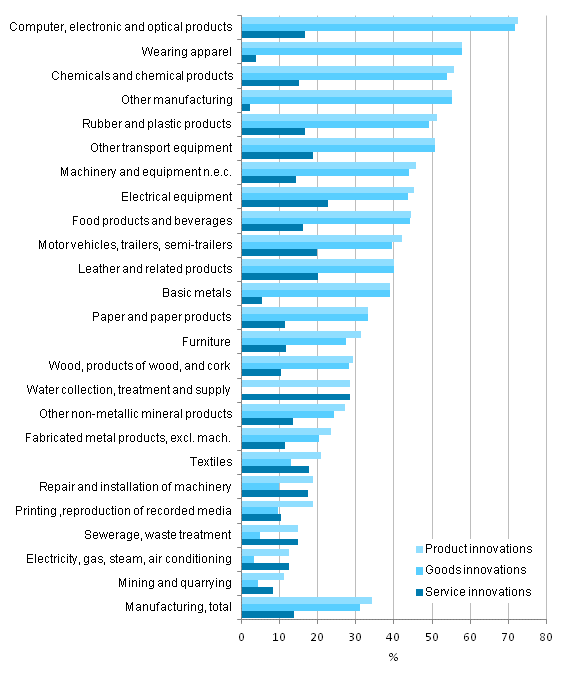
Figure 5. Enterprises with product innovations by industry in services 2010–2012, share of enterprises
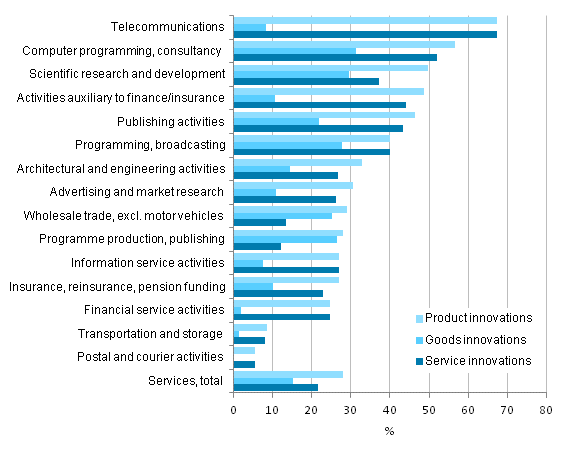
The product innovations introduced to the markets are primarily developed by the enterprise that launched the product. Good 80 per cent of enterprises that reported goods innovations had developed the goods themselves, and around one-half had developed them together with other enterprises or institutions. One in four of enterprises that had launched goods innovations had remodelled goods original produced by someone else, and around one in ten reported that goods innovations had been developed by others. In manufacturing, development work is carried out more goods inside the own enterprise than in service industries.
In service production enterprises relay on external developers and on development work carried out outside the enterprise somewhat more often than in development of goods innovations. For example, one in three enterprises that had introduced a service innovation to the markets reported that they had remodelled services produced by others.
Of the enterprises that had launched product innovations, nearly two out of three reported new products that were new from the viewpoint of the enterprise's markets. Good 70 per cent launched a product innovation that was new from the enterprise's perspective but similar products were already available from the enterprise's competitors on the enterprise's markets.
For example, among smaller class product innovators, 30 per cent only had new products for the market in question and nearly one-third reported products that were new both for the enterprise and the markets. By contrast, for around one-fifth of the largest sized product innovators, all innovations were new for the markets, and good one-half reported that they had launched both products that were new for the markets and products that were new only for the enterprise.
The product life-cycles and the role of product innovations naturally vary by industry. All in all, 11 per cent of the 2012 turnover of the examined enterprises was generated from innovations launched on the markets in 2010 to 2012; four per cent of turnover was generated from new products in terms of the enterprise's markets, seven per cent from products that were new to the enterprise. The share of product innovations of the turnover of enterprises that had made product innovations was close on one-fifth, 17 per cent, while the share in manufacturing was 23 per cent and eight per cent in services. The turnover from innovations among the smallest innovators in service industries represented one-fifth of the turnover, but for the largest service industry enterprises the share of innovations in turnover represented only five per cent of the combined turnover of the innovators.
Process innovations through joint development
The share of enterprises that had taken process innovations into use remained almost unchanged from previous years in 2010 to 2012. In manufacturing, around one-third of enterprises reported they had taken process innovations into use and one-quarter of service enterprises reported the same. In relative terms, most process renewals were adopted by enterprises in manufacture of rubber and plastic products, manufacture of computer, electronic and optical products, and in operations serving financing and insurance, as well as in computer programming, in each of which the share of enterprises that reported innovations represented over 40 per cent of enterprises in the sector. Process innovations were taken into use least frequently in manufacture of textiles and wearing apparel, and in transport and storage.
Process innovations were directed most commonly at manufacture and production, as well as process support functions just like in previous years. One in four manufacturing enterprises had renewed their manufacturing and production methods and close on one in five had renewed their support functions. In service industries, the share for production development was clearly lower, 13 per cent, but for support functions it was the same as in manufacturing, 18 per cent. One in ten of both manufacturing and service enterprises had taken into use innovations related to logistics or delivery and distribution systems.
Nearly 60 per cent of those that had taken process innovations into use had developed the innovations related to processes themselves. Transfer of knowledge and spreading of innovations is important also for processes because more than one-half of the innovators had developed the process innovations together with others and one-quarter had remodelled processes originally developed by others. Approximately one in six of enterprises that had taken process innovations into use reported that other enterprises or institutions had developed the innovation.
Ongoing projects become future innovations
Good one quarter of the surveyed enterprises reported projects related to the development of product or process innovations that had not so far resulted in innovations; the projects had either been discontinued during the survey period 2010 to 2012 or they were still ongoing at the end of 2012.
One in ten of the enterprises, had had discontinued development projects and one-quarter of enterprises – 30 per cent in manufacturing and 21 per cent in service industries – reported projects and measures that were continuing at the end of 2012. A considerable share of enterprises with innovation activities also had activities that aimed at future innovations.
Various types of resources are involved in innovation development
Development of innovations require many types of actions and measures that are focused on the industry and also, for example, according to each development stage. Concerning 2010 to 2012, enterprises reported different types of innovation activities almost similarly as in previous surveys.
Three out of four enterprises that had developed products or processes had had research and development activities (R&D), roughly one-half had ordered R&D from outside the enterprise and, for example, some 40 per cent had arranged or acquired training related to developing and implementing innovations. R&D, equipment acquisition related to innovations, acquiring of existing knowledge (like patents) and design were more common innovation activities in manufacturing than in services. Enterprises reported activities related to training and launching innovations on the market as frequently in manufacturing and in services. Large enterprises reported various types of innovation activities clearly more often than small enterprises.
Enterprises reported clearly less innovation expenditure in 2012 than in 2010 and 2008 when statistics on innovation expenditure were last compiled. 1) In 2012, innovation expenditure reported by enterprises amounted to a total of EUR 6.2 billion. In manufacturing, innovation expenditure decreased considerably from the previous measuring period, when the overall expenditure was nearly EUR six billion. In 2012, manufacturing enterprises reported that they had spent good EUR 4.5 billion on innovation activities. In surveyed service industries, a total of nearly EUR 1.7 billion was spent on innovation activities. The change compared to 2010, when the combined innovation expenditure of service industries was close on EUR 1.3 billion is in part explained by the industry expansion that was made.
In line with previous years, R&D expenditure represented a considerable share of all combined innovation expenditure in 2012. Other items total represented around one-quarter of the total expenditure in innovation activity.
Figure 6. Distribution of innovation expenditure in manufacturing 2012
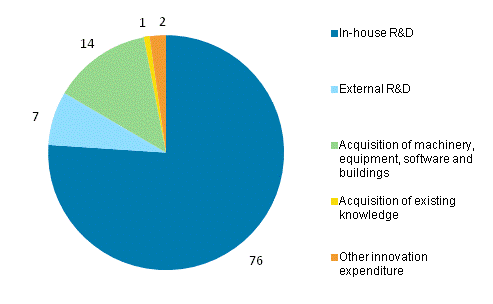
Figure 7. Distribution of innovation expenditure in services 2012
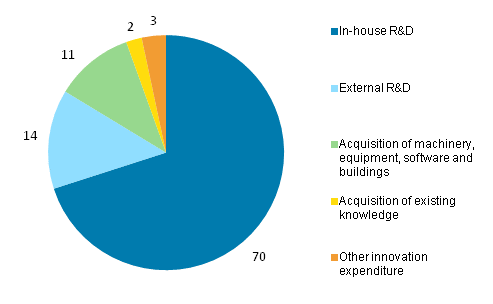
All in all, good one-third of enterprises that had developed products or processes received public funding for their innovation activity in 2010 to 2012. In manufacturing, 42 per cent had received funding, in services, 27 per cent. In relative terms, most public funding was received by large manufacturing enterprises of which, for example, 72 per cent received support from the State and 22 per cent from the EU. Of all medium size companies, good one-quarter reported support from the State and five per cent from the EU.
Measured by the number of enterprises that received funding, the State was the central source of funding for innovation activity. Altogether, 28 per cent of enterprises with innovation activity received public funding from the State. Nine per cent received support from local or regional authorities and six per cent from the EU. Three per cent of enterprises that reported innovation activity related to products and processes also reported that they had participated in the European Union’s Seventh Framework Programme for Research and Technological Development.
Equipment and material suppliers and private sector customers important in innovation activity
The use of different information sources, as well as cooperation with different cooperation partners in innovation activity, still present themselves as more important to large enterprises than to small enterprises. Large enterprises name various information sources and cooperation partners as having high importance more often than small companies.
The importance of various information sources was seen as quite similar in 2010 to 2012 in both manufacturing and service enterprises but manufacturing enterprises reported actual cooperation related to innovation activity more frequently than service enterprises and also named cooperation as more important in many respects.
All in all, 36 per cent of enterprises that had developed and taken product and process innovations into use reported cooperation related to innovation activity. In manufacturing, 41 per cent had participated in cooperation, in services, 30 per cent.
The main information sources and cooperation partners in 2010 to 2012 were, like in previous years, the own enterprise, other enterprises in the same group, and equipment and material suppliers. Customers that had previously been named as key information sources and cooperation partners were now for the first time inquired as divided into private and public sector customers. Based on the results, private sector customers are both important information sources and important cooperation partners. The importance of public sector customers as information sources and cooperation partners is clearly more modest. Only a few per cent of enterprises involved in innovation activity saw public sector customers as having high importance in cooperation related to innovation activity. As information sources, public sector customers had a high or moderate importance for approximately one in four enterprises with innovation activity.
Figure 8. Information sources for innovation activities in manufacturing and services 2010–2012, share of enterprises with innovation activities related to product and process innovations
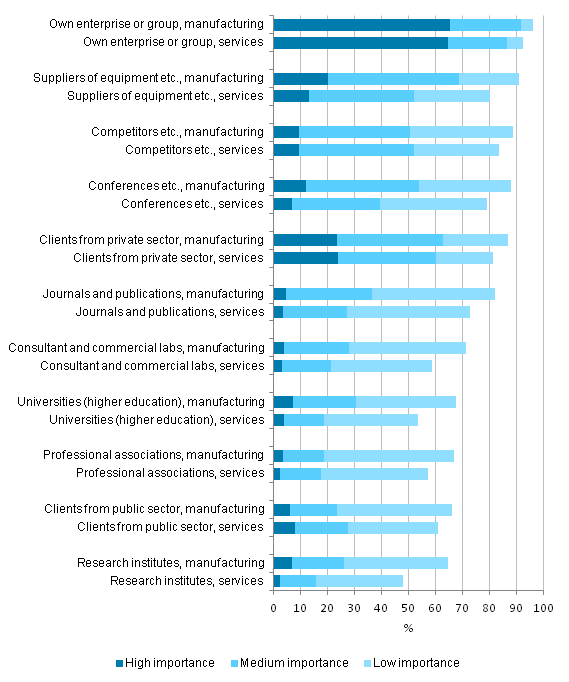
Figure 9. Co-operation partners for innovation activities in manufacturing and services 2010–2012, share of enterprises with innovation activities related to product and process innovations
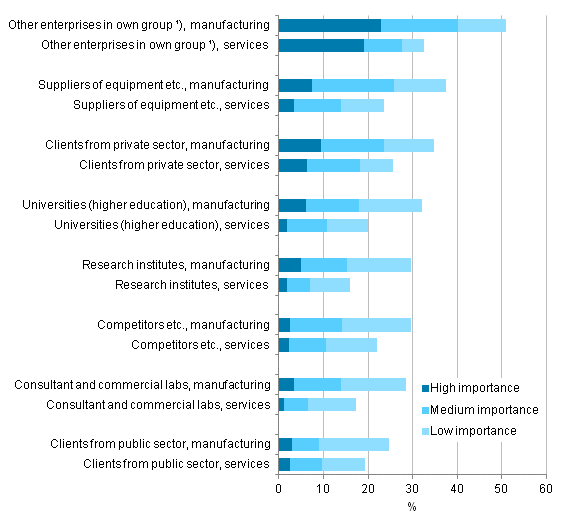
�) only enterprises within a group
Nearly all enterprises with cooperation related to innovation activity had cooperation in Finland in 2010 to 2012 just like in previous surveys. Of those with cooperation, 68 per cent reported having cooperation partners in Europe and 27 per cent in the United States. All in all, 15 percent had cooperation with parties located in China or India and around one in five reported cooperation in other countries or areas.
Innovations are protected to ensure competitiveness
Manufacturing enterprise reported the use of patents, utility design applications, and registration of the copyright of design in order to promote and maintain the competitiveness of product and process innovations more frequently than service enterprises did. Copyrights and trademarks are, however, nearly of equal importance for both manufacturing and service enterprises.
Being a forerunner, the complexity of products and confidentiality are clearly more frequently used methods to maintain and promote competitiveness of innovations than formal protective measures. Nearly 90 per cent of enterprises that took product and process innovations into use in 2010 to 2012 found speed and being a forerunner to be a way to promote and maintain the competitiveness of an innovation. A majority saw speed and being a forerunner as having a high or at least moderate importance. Almost 80 per cent of enterprises with innovations in 2010 to 2012 felt that the complexity of products was a way to protect the innovation and ensure competitiveness. A majority of these – three out of four – saw this to have high or at least moderate importance. Confidentiality was seen to be as important for competitiveness as the complexity of products.
Figure 10. Methods for maintaining or increasing the competitiveness of product and process innovations introduced 2010–2012, share of enterprises with the introduction and implementation of product and process innovations
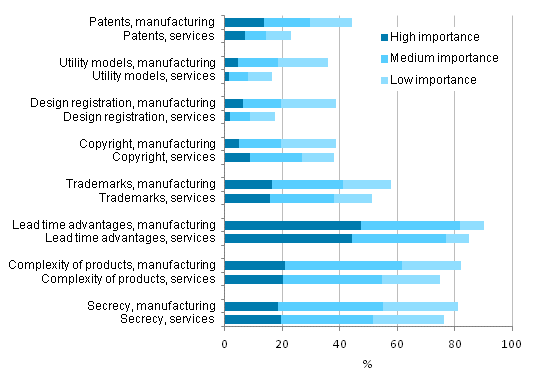
1) Innovation expenditure must often be determined by assessment because they are not necessarily monitored in the enterprise's bookkeeping and accounting systems. A change in the wording of a question may affect the comparability of the latest data with previously released data.
Source: Innovation 2012, Statistics Finland
Inquiries: Mervi Niemi 09 1734 3263 (9.6.2014 => 029 551 3263), tiede.teknologia@stat.fi
Director in charge: Hannele Orjala
Updated 5.6.2014
Official Statistics of Finland (OSF):
Innovation [e-publication].
ISSN=1797-4399. 2012,
3. Innovation activity related to products and processes in 2010 to 2012
. Helsinki: Statistics Finland [referred: 28.12.2025].
Access method: http://stat.fi/til/inn/2012/inn_2012_2014-06-05_kat_003_en.html

